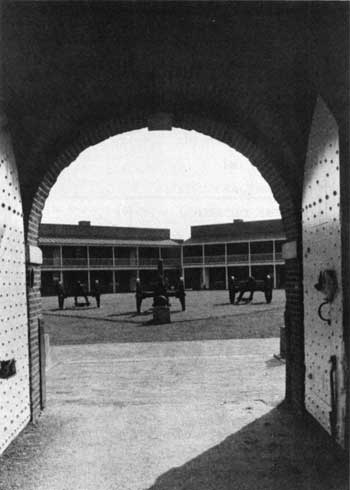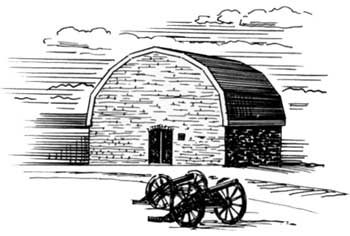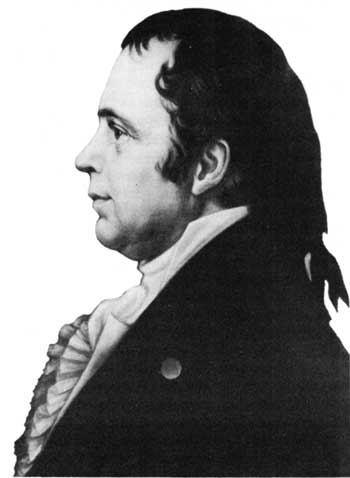|
FORT McHENRY National Monument and Historic Shrine |
 |

The interior of Fort McHenry as seen through the sally
port.
FORT McHENRY occupies a preeminent position among the historic shrines and monuments of our country by reason of its special meaning in American history. It was a glimpse of the American flag waving defiantly over the ramparts of Fort McHenry that inspired Francis Scott Key to compose our national anthem.
Here, where the flag flies day and night, the Stars and Stripes attains a special significance for Americans. Here on these historic ramparts the visitor can sense and appreciate that surge of inspiration, born amid the welter of bursting bombs and blazing rockets, which compelled Francis Scott Key to create a classic expression of American ideals and patriotism. Here is symbolized the triumph of American arms and valor over a foreign invader.

Fort Whetstone 1776—97; Fort McHenry, 1798—1812
The tip of a narrow peninsula, called Whetstone Point, was considered of great strategic value for the defense of Baltimore as early as the Revolutionary War. The peninsula separated the North West Branch and the Ferry Branch of the Patapsco River. (Now, North West Branch is called Northwest Harbor, and Ferry Branch is part of the main estuary of the Patapsco River.) Since all port facilities for Baltimore were on the North West Branch, which was regarded as the city's harbor, the important value of the point could not be overlooked in any plan to erect defenses to guard the water approaches to the city.
During the Revolutionary War, the Provincial Convention of Maryland directed its standing committee, the Council of Safety, to provide for the defenses of Baltimore. A group of local patriots agreed to undertake the project, and on March 16, 1776, they reported to the Council that, "Our fort at Whetstone is ready to mount 8 guns and we shall use every exertion to expedite it." Although the fort never came under enemy fire, it deterred the British cruisers which operated in Chesapeake Bay from molesting Baltimore. In 1781, Fort Whetstone, as the defense works were then called, consisted of a battery, magazine, military hospital, and barracks. The scattered ordnance returns indicate that the types and numbers of cannon emplaced at the fort changed frequently.
The successful conclusion of the Revolutionary War and the adoption of the Federal Constitution did not bring the expected freedom from affairs in Europe. Relations with England were strained and both nations were frequently on the verge of armed conflict. Alarmed for the safety of the chief commercial city of Maryland, the House of Delegates, in 1793, passed a resolution authorizing the Governor of the State, upon application of "the President, to grant permission to the Federal Government to erect a fort, arsenal or other military works" on Whetstone Point. Congress, in March of the following year, enacted legislation to fortify the principal seaports of the young republic, and, in the funds appropriated for this purpose, was $4,225.44 for the erection of a 20-gun battery and small redoubt to defend Baltimore.
John Jacob Ulrich Rivardi, an experienced artilleryman and military engineer, was directed by the Secretary of War to visit the city, draw up plans for a permanent harbor defense, select a qualified individual to execute them, and then proceed to Norfolk on a similar mission. He was also ordered to forward a copy of his plans to the Governor of the State and to submit to his authority.
Rivardi found conditions in Baltimore extremely favorable. Governor Lee was cooperative, the local citizenry were zealous to assist, and, of utmost importance, the quality of the soil on Whetstone Point was ideal for erecting batteries. The small appropriation, however, compelled Rivardi to limit his recommendations to measures designed to improve the existing defense works, which consisted of an upper and lower battery and an imperfectly designed redoubt which he termed a star fort. Samuel Dodge was appointed to supervise the program, which he accomplished after a fashion, mainly with voluntary labor performed by the residents of the city.
In 1798, Maj. Louis Tousard was ordered to survey the existing defense works and submit recommendations for their improvement. He regarded as insufficient the $20,000 allotted for this purpose, and, rather than risk his professional reputation, he turned his plans over to a committee of local citizens who agreed to raise an additional $10,963.44 by popular subscription and to supervise the program.
It is probable that the present star fort, located to the rear of the Revolutionary works, was erected during this period. A report of the Secretary of War, dated 1806, mentions that Fort McHenry was a "regular fortification of mason work, with batteries, magazines, and barracks, erected principally in years 1798, 1799, 1800." This view is further confirmed by the fact that the largest appropriations for Fort McHenry were voted for these 3 years.

James McHenry.
Shortly before the turn of the century, James McHenry, Secretary of War and a resident of Baltimore, was honored by the bestowal of his name on the fort. McHenry was born at Ballymena, County Antrim, Ireland, on November 16, 1753. In 1771, he immigrated to Philadelphia, where he studied medicine. At the outbreak of the Revolutionary War, he volunteered for service in the Continental Army. During his army career he served first as a surgeon and later as a secretary to George Washington. After the war, McHenry became active in Maryland politics and represented the State at the Constitutional Convention in Philadelphia. An avowed Federalist, he served as Secretary of War from 1796 to 1800, when he resigned after a dispute with President Adams.
From its completion to the outbreak of the War of 1812, the history of the fort is routine and uneventful. The organization, in 1808, of the first mobile horse-drawn artillery unit in the United States Army by Capt. George Peter at the direction of the Secretary of War is the most interesting event to occur at Fort McHenry during this period. The carriages and limbers for the two 6-pound pieces used were constructed by the garrison artificers.

|
|
Last Modified: Mon, Dec 2 2002 10:00:00 am PDT |


